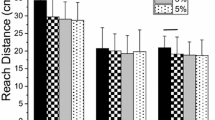Summary
The posture of cats trained to stand freely on a platform was studied during static tilts (up to ±30°). Vertical projection of the center of mass on the support surface, as well as limb orientation in space and degree of limb flexion, varied minimally with platform tilt angle. The limbs' main axes were kept almost lined up with the vertical. This data indicates that postural control is simplified by strong internal constraints which limit the number of possible postural configurations. The mechanical advantages of this postural strategy are also considered. Finally, the data are discussed in the context of previously held views on the role of vestibular and neck reflex control of posture in intact animals.
Similar content being viewed by others
References
Bernstein N (1967) The co-ordination and regulation of movements. Pergamon Press, Oxford
Brookhart JM, Parmeggiani PL, Petersen WA, Stone SA (1965) Postural stability in the dog. Am J Physiol 208: 1047–1057
Brookhart JM, Talbott RE (1974) The postural response of normal dogs to sinusoidal displacement. J Physiol 243: 287–307
Clément G, Magnin M (1983) Visual influence on postural control in the cat. Exp Brain Res 52: 429–438
Coulmance M, Gahéry Y, Massion J, Swett JE (1979) The placing reaction in the standing cat: A model for the study of posture and movement. Exp Brain Res 37: 265–281
Cross CE (1973) Analysis of postural dynamics in the dog. Ph.D. Thesis, Oregon State University, Corwallis, Oregon
Ezure K, Wilson VJ (1983) Dynamics of neck-to-forelimb reflexes in the decerebrate cat. J Neurophysiol 50: 688–695
Goslow GE, Reinking RM, Stuart DG (1973) The cat step cycle: Hind limb joint angles and muscle lengths during unrestrained locomotion. J Morphol 141: 1–41
Gray J (1944) Studies in the mechanics of the tetrapod skeleton. J Exp Biol 20: 88–116
Haour R, Massarino R, Massion J, Swett JE (1976) A device used for study of postural reactions in the quadruped. Electroenceph Clin Neurophysiol 40: 427–431
Lindsay KW, Roberts TDM, Rosenberg JR (1976) Asymmetric tonic labyrinth reflexes and their interaction with neck reflexes in the decerebrate cat. J Physiol 261: 583–601
Magnus R (1926) Cameron prize lectures on some results of studies in the physiology of posture. Lancet 211: 531–536
Manter JT (1938) The dynamics of quadrupedal walking. J Exp Biol 15: 522–540
Massion J (1979) Role of motor cortex in postural adjustments associated with movement. In: Asanuma H, Wilson VJ (eds) Integration in the nervous system. Igaku-Shoin, Tokio, pp 239–260
Miller S, van der Burg J, van der Meché (1975) Coordination of movements of the hindlimbs and forelimbs in different forms of locomotion in normal and decerebrate cats. Brain Res 91: 217–237
Mittelstaedt H (1964) Basic control patterns of orientational homeostasis. Symp Soc Exp Biol 18: 365–385
Nashner LM, Black FO, Wall C (1982) Adaptation to altered support and visual conditions during stance: patients with vestibular deficits. J Neurosci 2: 536–544
Nashner LM, McCollum G (1984) The organization of human postural movements: A formal basis and experimental synthesis. Behav Brain Sci (in press)
Rademaker GGJ (1931) Das Stehen. Springer, Berlin
Roberts TDM (1973) Reflex balance. Nature 244: 156–158
Roberts TDM (1978) Neurophysiology of postural mechanisms. Butterworths, London
Rushmer DS, Russell CJ, Macpherson J, Phillips JO, Dunbar DC (1983) Automatic postural responses in the cat; responses to headward and tailward translation. Exp Brain Res 50: 45–61
Schor RH, Miller AD (1981) Vestibular reflexes in neck and forelimb muscles evoked by roll tilt. J Neurophysiol 46: 167–178
Schuster D, Talbott RE (1980) Optimal and adaptive control in canine postural regulation. Am J Physiol 239: R93-R114
Talbott RE, Brookhart JM (1980) A predictive model study of the visual contribution to canine postural control. Am J Physiol 239: R80-R92
Author information
Authors and Affiliations
Rights and permissions
About this article
Cite this article
Lacquaniti, F., Maioli, C. & Fava, E. Cat posture on a tilted platform. Exp Brain Res 57, 82–88 (1984). https://doi.org/10.1007/BF00231134
Received:
Accepted:
Issue Date:
DOI: https://doi.org/10.1007/BF00231134




